MULLEN HISTORY - HOOKER COUNTY
by Mabell Cox
Entry T19 from the History of Hooker County Nebraska
with permission of the Hooker County Historical Society
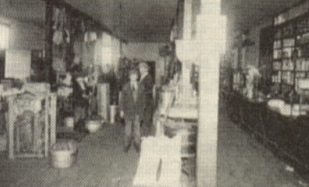
Interior view of the H.J.Lowe Store or the
Cudebec General Store in early 1900's.
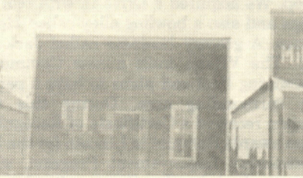
The Mullen Post Office June 9, 1910.

The sandy Main Street of Mullen. The 1910 Roseberry
building in the foreground, view is looking east.
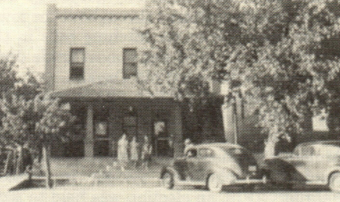
The Ham-Commercial Hotel August 1939.
Notice change of steps and porch railing,
also the absence of the big tree now.
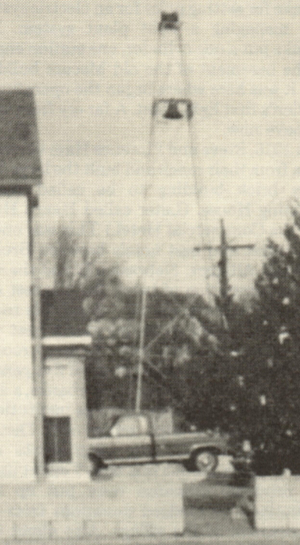
Old Bell and Siren on tower behind the
Gorsuch Apartments (Old Evergreen Hotel).
Both used for fires, curfews, etc.
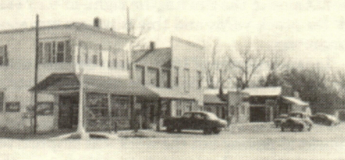
Buildings north side of Main Street, east of
intersection east. Note the lamp post on the corner of
the large building, next, Dutton Store 2 story building
with apt. above, a residence, Bakery, a building
and the last one is the old Fosdick building, 1967.

The north side of the Rodeo Arena grounds in 1951.
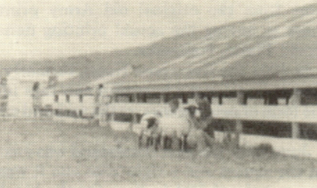
Fair Exhibit building for livestock.
The village of Mullen had a very humble
beginning. It started with a small general
store or trading post called Trefern Post, run
by L. Trefern which was located about one
mile west of the present townsite. In the fall
of 1887, the Grand Island and Wyoming
Railroad laid tracks across what is now
Hooker County. Mr. Trefern and the railroad
could not agree on land price so they put in
switches about a mile east of the trading post.
They converted a box car into a telegraph
station and called it Siding Nine, later named
Mullen after Charles D. Mullen of Lincoln.
At that time Mr. Mullen was Chief Clerk for
Mr. D.E. Thompson, Division Superinten-
dent of the C.B. and Q. but the actual naming
was done by T.E. Calvert, General Superin-
tendent of the railroad. Needless to say,, Mr.
Trefern moved his "Post" to Mullen which
was to become the county seat of Hooker
County. The town site was surveyed at this
time and platted by Amos Gandy and George
W. Trefern on May 7, 1888. The records were
kept in the newly established Thomas
County Courthouse 25 miles east.
The first post office was established in 1887
with M.A. Hammall as postmaster at the first
site one mile west of Mullen but when the site
changed, so did the post office and it was
moved to the new site May 7, 1888.
Hooker County became official on March
29, 1889. County Commissioners were ap-
pointed and met in a special session to float
a bond of $1500 to build a County Court-
house. It was built the summer of 1889 and
accepted by the commissioners on November
16, 1889. It was two rooms with a hall
between. It is still in use as part of a dwelling.
In 1896 Wilson Hewitt established the first
hotel or rooming house in Mullen. It was
called the Hewitt Hotel. Before this in 1889,
Webster Bowers became the first photogra-
pher in this area. He traveled by team and
buggy to ranches, roundups, any place he felt
might be of interest. He took many, many
pictures of Mullen and its people. When some
of his children had scarlet fever, a number of
his plates (negatives then) had to be de-
stroyed but he has still left a bountiful
heritage for us, of the "Early Days of
Mullen."
About this period of time Henry J. Lowe,
an early settler from Kansas was camped on
the Dismal River on his way back to Kansas
when his horses escaped. The next day he
found them but decided to trade them for
merchandise and open a store in Mullen. This
store remained in the family for years. (Read
the Lowe stories and James story).
Fred M. Cudebec established a general
store. A Livery Stable was soon built to
accommodate the needs of travelers and the
town folk.
The first newspaper in Mullen was started
in 1887 and named the Mullen Enquirer for
about four years, then it was changed to the
Hooker County Tribune. This paper is still
active in our fair city but has changed hands
and foremats a number of times. They have
gone from the original old Army printing
press to having the actual printing done in
North Platte, Nebraska.
In 1901 the Evergreen Hotel, formerly the
Hewitt Hotel, got a beautiful new face lift in
the form of new porches on the east and south
sides.
June 1902, the new Bandstand was erected
on the square and a right nice one it was. It
was completed just in time for the big July
4th Celebration and became the gathering
place for concerts by the Town Band that
played for parades and all sorts of entertain-
ments. As the streets were improved and it
became necessary to move the bandstand, it
was given to the Boy Scouts for a cabin and
moved out to the Middle Loup River where
they often camped. Later it was moved out
to the Mullen Golf Course where it is still in
use as a storage building and a lunch stand.
Believe it or not in 1903, Mullen had two
doctors listed, Dr. Edward Dodd, Physician
and Surgeon and Dr. Little. Dr. O.W. Kream-
er, a dentist and in that same year, Col. W.R.
Hayward was a lawyer as well as the County
Attorney.
O.F. Hamilton, a lawyer and land locater
came to Mullen in 1905 and set up his office
in the Cudebec Drug Store building. He was
later to figure prominently in the most
famous murder and trial Mullen ever had -
he was the one murdered. (For more details
see Mysterious Hamilton case in Bits and
Pieces.)
In the early and mid 1900's, Mullen had the
appearance of some of the "Old West" towns
shown in Wild West shows, TV and stories
at present. The main difference was the
beautiful green hills around the outside of the
little town. Most of the buildings, stores and
houses, as well, were pretty drab, plain,
weathered wooden structures that gave the
impression of age even though they were not
really that old. There were some exceptions,
of course, such as neatly painted houses, the
new brick Court House, the Roseberry's
Store, huge for the time and place, a solid
concrete two-story building. The cement had
been mixed by hand with a hoe and mortar
boxes. The upper story was an Opera House,
complete with footlighted stage, colorful
settings and two or three backdrops, (outdoor
scene and one the interior of a log cabin -
should have been a soddie for here). There
were 2 small but complete dressing rooms at
either corner of the passageway back of the
stage. This large room was used for dances
and gatherings of all kinds and later was to
be the setting for the first movies, silent of
course, that were brought to Mullen. Later,
"talkies" were shown and enjoyed by all,
which were used for many years. In those
early years there were no tall shade trees or
lovely lawns. About the only tall things were
the windmills scattered throughout the town.
There were five or six hitching rails in the
streets and the sand was almost ankle deep.
(Those were the good old Days).
The Village of Mullen was incorporated
about 1907.
May 1915, a Franchise was given to the
Mullen Telephone Company to operate and
conduct a telephone system in Mullen.
February 1916, an election was held to issue
$10,000 in bonds for the purpose of erecting,
constructing, locating and supplying water
works and water supply and for the purchas-
ing of fire extinguishing apparatus for Mul-
len. In 1917 a Franchise was given to R.C.
Franke for setting poles for an electric system
and managing a light plant system. Mr.
Franke put a one cylinder, one station engine
in the basement of the old Mecure building
and it was here where began the operation of
Mullen's first light plant. A far cry from what
we have now.
In 1916, Steve and Florence Ham moved to
town from their ranch and built the large two-
story brick building to be called Ham's
Rooming House. (Later called Ham's Hotel
and the Commercial Hotel.) This was one of
the largest and best hotels between Broken
Bow and Alliance, Nebraska. It had the well
earned reputation of being the cleanest and
best kept accommodations along this route.
It was advertised as having steam heat and
hot and cold running water in every room.
By 1918, Mullen could boast of five general
stores, two hardware stores, two banks, a drug
store and several other business institutions,
four churches, a high school and District
Elementary school, city water works and
electric lights. About this time 7 street lights
the principal crossings were put up and
maintained by pledged donations from the
businessmen of the village. Also about this
time the Potash Hiway Association had been
formed between Broken Bow and Alliance so
Mullen was getting a highway going east and
west.
In 1918, according to an article from the
Hooker County Tribune, "There was some
misunderstanding of the fire bell code and
every time the bell rang everybody in town
rushed out expecting to see a fire. The
following code was adopted - constant
ringing, FIRE; 6 taps, pause, 6 more, PRAC -
TICE; 3 taps, pause, 3 more, Business
Meeting. This apparently solved the prob-
lem.
October 1919, saw a new business come into
being. L.E. Harding, W.A. Harding and Roy
Tucker started the Mullen Sales Ring Com-
pany. A tract of land was purchased along the
south side of the Burlington right-of-way east
of the stock yards and this business was soon
underway.
In late summer of 1919, it was decided upon
to pave several of Mullen's business district
streets. The contract was let to George H.
Hawley and by October 31, there was three
blocks of paving but the work was stopped for
the winter and planned to resume in the
spring. What an improvement! In 1920
cement walks were added. A loud harah from
the ladies! By 1921 Mullen had grown enough
and the youth were considered to be creating
a bit of a problem after nightfall so a curfew
ordinance was put into effect. The folks seem
to think it really helped.
Long about this same time, October of
1920, Mullen received the two cluster street
lights as a gift from the local American Legion
Post. From the Hooker County Tribune,
October 8, 1920, "The second cluster light for
Mullen is being placed in position this week
by Frank Fitzgerald, the same having been
presented to the city the local post of the
American Legion. Its stand will be at what is
known as the west main square and its
purpose will be to light the way to the Opera
House and better assist those seeking belated
repose at either of the hotels. While it is a
much needed improvement, the hand from
whence it came and the history it will make
for our little city will endure throughout time
- long after memory of those who enjoyed
the gleam of its bright light has faded from
view." The 1920's were indeed a growing and
expanding time for the young town of Mullen.
The 30's, we, however saw a slowing down of
new things in town. Although a Bowling Alley
was started in the basement of "Wright's
Delicatessan", the bakery changed hands
several times, the new businesses were
applauded. During that decade we again had
two doctors; Dr. L.E. Valentine and Dr. C.E.
Buhl.
The early 40's brought World War II and
many young men answered their country's
call. The people at home did their share by
conducting one of the biggest scrap drives in
the state of Nebraska. (See Hooker County
Heads the Nation). The schools and Post
Office sold Savings stamps and Bonds.
People stayed home more because gas was
rationed.
A boom both in businesses and people
came in the 1950's. Mullen had a new
Machine Shop, Western Clothing and Music
Store, a Dairy, Body Shop, Electric business,
2 new Cafes; The Jewel Diner on Hiway 2 and
the Mullen Cafe on Main Street, a Jewelry
store, Johnson Feed Store, Cash and Carry
Lumber Company and various others. On the
Cultural side a Community Chorus was
organized and an Easter Contata was given.
They also did Christmas music. Several
Community plays were given, much to the
delight of both the givers and the audience.
The 1960's again saw many changes. Jack
Carlson started his Implement (John Deere)
Shop. We acquired a Drive-in with real Car
Hops and also a bowling alley called Hondo
Lanes. A grocery business called Jack and
Jill. The Village built a new Community
Swimming Pool and plans to have a park in
the surrounding area. During this time
Mullen received a Certificate of Recognition
at an awards Banquet in Lincoln for the 1960
Community Improvement Program, which
had resulted in the Community Improv-
ement Committee's efforts through coordina-
ting some of the activities of Mullen. In this
same year the American Legion sponsored
the Mullen Rodeo which was named the third
best approved rodeo in Nebraska by mem-
bers of the Nebraska State Rodeo Associa-
tion.
By the 1970's Toby's Automotive Store
opened. The Mrs. Jaycees sponsored their
first Junior Miss Pageant in 1978. The
Bicentennial of the Nation was celebrated in
Mullen. Don Searcy of Kearney, Nebraska
was the speaker at the Mullen ceremonies to
a crowd of about 200, which he cited, that at
a similar program in Omaha had less than one
third this number of attendance. Mayor J.E.
Macke accepted a Bicentennial certificate
and flag for the town and Frank Sexton,
chairman of the county commission, accepted
them for the county. Bicentennial flags were
also presented to the elementary and high
schools. The Elementary Art department
designed a large Bicentennial flag with grades
1-6 participating. (This flag was later given
to the Historical Society of Mullen.) Others
taking part in the program were Kathy
Andrews - American Legion Auxiliary; Mr.
and Mrs. H.J. Cox - Local Bicentennial
committee; RaAnn Christensen - Mrs. Jay-
ceees; Music - Ruth Bassett and a group from
the schools; Macke Dance Band members
that were popular in the Sandhills area in the
1930's, '40's, and '50's.
Again the 1980's have held changes and
improvements. Many new businesses have
come on the scene; The Sandhills Packing
Company; Big Red's Cafe; The Butcher
Block; B & D Enterprises; L & L Sales and
Service; Bragg Construction; Mullen Feed
and Supply and many others. In 1984 a Cable
TV system was constructed and put to use for
the residents of Mullen.
The first site of Mullen has now become the
Fair and Rodeo Grounds. It has a big fenced
arena, covered bleachers, new exhibit build-
ings and an enclosed lunch stand. To the
south of this area is the improved Airport
runway.
Looking down our well kept main street of
1988, it is hard to visualize the changes of the
sandy streets with no sidewalks of long ago.
The biggest Steel quonset of the Mullen Feed
and Supply replacing the old Sandhills
Commercial Company and Citizen Bank
block and across the street the one story
white Lowe Building of today would have
been a two story building with the upper floor
being used for court, programs and a lodge
hall. The old "Doc Walker" building hasn't
had any major structure changes, thanks to
the sturdy cement blocks made right here in
Mullen in early 1900. West to the Vinton
Feed Store, it's located on the site of the
Roseberry building destroyed by fire. Look-
ing across the street to the north, the old
Evergreen Hotel would certainly not recog-
nize itself as the present day Gorsuch Apart-
ments, altho the building was re-re-remod-
eled but never completely torn down. East of
this we see the old Commercial Hotel and
that is one building that has seen little
change. True, the steps now go up the side of
the porch instead of out front and the brick
columns have been filled in with brick to
replace the iron pipe there before - but it
remains a stalwart guard to connect the old
with the new.
While Mullen has never been a big town,
it has been consistent in its slow and steady
growth. One can get most of the necessities
here, there are good roads and cars to take
you to other places when necessary. The
people of Mullen are willing to work together
for the good of the town and it shows in the
many community improvements that we
have. Now in the year 1988, the Centennial
Committee for our 100 year celebration is
working and planning for a great year. The
committee is made up of a representative of
each organization, club, business and anyone
interested in giving suggestions. A number of
these groups are holding special activities to
raise funds for the year '89. Centennial
Calendars are now available, the Centennial
Rifle is on display at the Abbott Bank in a
display case constructed by Walter Barne-
bey, son of C.M. Barnebey a very early 1900
resident. Orders are being taken for Centen-
nial Belt Buckles. Mullen is inviting you
readers to come join our celebrations -
March 29, 1989, the Kick-off with Dr. Robert
Manley as guest speaker; April 22-23, '89,
Mullen is hosting the State Barbwire Collec-
tors Convention; Alumni Week-end June 10;
July 1, 2, 3,4, 1989 will be the Centennial
Celebration with parades, (kids and Centen-
nial); Arts and Crafts; flea market; style show;
old time Saturday night; community church
service; fireworks; rodeo; barbeque; all kinds
of games plus much more. Do the people of
Mullen and the surrounding area work
together? YOU BET!







